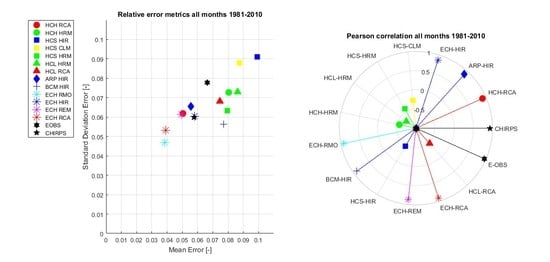Validation of Satellite, Reanalysis and RCM Data of Monthly Rainfall in Calabria (Southern Italy)
Abstract
1. Introduction
2. Materials and Methods
2.1. Study Area
2.2. Data Sources
- The February 2019 update of CHIRPS (Climate Hazards group InfraRed Precipitation with Station data), version 2.0, with a 0.05° resolution and available from January 1981 until January 2019 [37];
- The 18.0e version (released in November 2018) of E-OBS, a gridded version of the European Climate Assessment Dataset, with a 0.25° resolution and which provides data from January 1950 until June 2018 [8];
- ENSEMBLES, funded by the European Commission’s 6th Framework Programme through contract GOCE-CT-2003-505539, consists of several GCM-RCM combinations, furnished at the E-OBS 0.25° grid [17]. These GCM-RCM combinations use a Global Climate Model (Table 1) to drive a Regional Climate Model (Table 2). As an example, the HCH-RCA acronym refers to the Sveriges Meteorologiska och Hydrologiska Institute (SMHI) regional RCA Model driven by the global Hadley Climate Model 3 (HCH) with high sensitivity. See Table 3 for a full list of GCM-RCM combinations and acronyms.
- CHIRPS and E-OBS are up-to-date, state-of-the-art products: they are regularly maintained and updated and they are the subject of several validation studies [44];
- ENSEMBLES models have already been selected and studied in previous projects; they are easily comparable with E-OBS, as they share the same spatial resolution and the same space grid; furthermore, they have data available for the 1951-2010 time-period.
2.3. Validation Metrics
2.3.1. Mean Error and Standard Deviation Error
2.3.2. Pearson Correlation Coefficient
3. Results
4. Discussion
5. Conclusions
Author Contributions
Funding
Acknowledgments
Conflicts of Interest
Appendix A
| Code | Name | Code | Name |
|---|---|---|---|
| 900 | Albidona | 2090 | Fabrizia |
| 930 | Villapiana Scalo | 2130 | Roccella Ionica |
| 970 | Cassano allo Ionio | 2150 | Fabrizia - Cassari |
| 1000 | Domanico | 2160 | Gioiosa Ionica |
| 1010 | Cosenza | 2200 | Antonimina |
| 1030 | San Pietro in Guarano | 2210 | Ardore Superiore |
| 1060 | Montalto Uffugo | 2230 | Plati’ |
| 1092 | Camigliatello – Monte Curcio | 2260 | San Luca |
| 1100 | Cecita | 2270 | Sant’Agata del Bianco |
| 1120 | Acri | 2290 | Staiti |
| 1130 | Torano Scalo | 2310 | Capo Spartivento |
| 1140 | Tarsia | 2320 | Bova Superiore |
| 1180 | Castrovillari | 2340 | Roccaforte del Greco |
| 1230 | San Sosti | 2380 | Montebello Ionico |
| 1360 | Longobucco | 2450 | Reggio Calabria |
| 1380 | Cropalati | 2510 | Scilla |
| 1410 | Cariati Marina | 2540 | Santa Cristina d’Aspromonte |
| 1440 | Crucoli | 2560 | Sinopoli |
| 1455 | Ciro’ Marina - Punta Alice | 2580 | Molochio |
| 1500 | Nocelle - Arvo | 2600 | Cittanova |
| 1580 | Cerenzia | 2610 | Rizziconi |
| 1670 | Cutro | 2670 | Arena |
| 1675 | Crotone - Papanice | 2690 | Feroleto della Chiesa |
| 1680 | Crotone | 2710 | Mammola - Limina C.C. |
| 1695 | Crotone - Salica | 2730 | Mileto |
| 1700 | Isola di Capo Rizzuto - Campolongo | 2740 | Rosarno |
| 1740 | San Mauro Marchesato | 2760 | Joppolo |
| 1760 | Botricello | 2780 | Zungri |
| 1780 | Cropani | 2800 | Vibo Valentia |
| 1820 | Soveria Simeri | 2830 | Filadelfia |
| 1830 | Albi | 2890 | Tiriolo |
| 1850 | Catanzaro | 2940 | Nicastro - Bella |
| 1910 | Gimigliano | 2990 | Parenti |
| 1940 | Palermiti | 3000 | Rogliano |
| 1960 | Chiaravalle Centrale | 3040 | Amantea |
| 1970 | Soverato Marina | 3060 | Paola |
| 1980 | Serra San Bruno | 3090 | Cetraro Superiore |
| 2040 | Monasterace - Punta Stilo | 3100 | Belvedere Marittimo |
| 2086 | Mongiana | 3150 | Laino Borgo |
| 3160 | Campotenese |
| Dataset | 1951–1980 (mm/year) | 1981–2010 (mm/year) |
|---|---|---|
| HCH-RCA | 748 | 716 |
| ARP-HIR | 723 | 648 |
| ECH-HIR | 1146 | 1076 |
| HCS-CLM | 810 | 777 |
| HCS-HRM | 746 | 681 |
| HCL-HRM | 550 | 471 |
| HCH-HRM | 783 | 763 |
| ECH-RMO | 733 | 733 |
| BCM-HIR | 1586 | 1485 |
| HCS-HIR | 1217 | 1179 |
| ECH-REM | 672 | 662 |
| ECH-RCA | 777 | 744 |
| HCL-RCA | 904 | 790 |
| E-OBS | 617 | 596 |
| CHIRPS | - | 766 |
| Gauge data | 1128 | 986 |
References
- IPCC. Climate Change 2013: The Physical Science Basis. Contribution of Working Group I to the Fifth Assessment Report of the Intergovernmental Panel on Climate Change; Stocker, T.F., Qin, D., Plattner, G.-K., Tignor, M., Allen, S.K., Boschung, J., Nauels, A., Xia, Y., Bex, V., Midgley, P.M., Eds.; Cambridge University Press: Cambridge, UK; New York, NY, USA, 2013; p. 1535. [Google Scholar]
- Tapiador, F.; Navarro, A.; Levizzani, V.; Garcia-Ortega, E.; Human, G.J.; Kidd, C.; Kucera, C.; Kummerow, C.; Masunaga, H.; Petersen, W.; et al. Global precipitation measurements for validation climate models. Atmos. Res. 2017, 197, 1–20. [Google Scholar] [CrossRef]
- Bai, L.; Shi, C.; Li, L.; Yang, Y.; Wu, J. Accuracy of CHIRPS satellite-rainfall products over mainland China. Remote Sens. 2018, 10, 362. [Google Scholar] [CrossRef]
- Berrisford, P.; Dee, D.P.; Poli, P.; Brugge, P.; Fielding, R.; Fuentes, M.; Kallberg, P.W.; Kobayashi, S.; Uppsala, S.; Simmons, A. The ERA-Interim Archive Version 2.0. Tech. Rep. 1, ECMWF (2011). Available online: https://www.ecmwf.int/node/8174 (accessed on 3 May 2019).
- ENSEMBLES. Available online: http://ensembles-eu.metoffice.com (accessed on 2 May 2019).
- EURO4M. Available online: http://www.euro4m.eu (accessed on 2 May 2019).
- UERRA. Available online: http://www.uerra.eu (accessed on 2 May 2019).
- Haylock, M.; Hofstra, N.; Klein Tank, A.; Klok, E.; Jones, P.; New, M. A European daily high-resolution gridded dataset of surface temperature and precipitation. J. Geophys. Res. 2008, 113, D20119. [Google Scholar] [CrossRef]
- NCEP-CFS. Available online: https://www.ncdc.noaa.gov/data-access/model-data/model-datasets/climate-forecast-system-version2-cfsv2 (accessed on 2 May 2019).
- Giorgi, F.; Mearns, L. Introduction to special section: Regional climate modeling revisited. J. Geophys. Res. 1999, 104, 6335–6352. [Google Scholar] [CrossRef]
- Wang, Y.; Leung, L.R.; McGregor, J.L.; Lee, D.K.; Wang, W.C.; Ding, Y.; Kimura, F. Regional climate modeling: Progress, challenges and prospects. J. Meteorol. Soc. Jpn. 2004, 82, 1599–1628. [Google Scholar] [CrossRef]
- Hagedorn, R.; Doblas-Reyes, F.J.; Palmer, T.N. The rationale behind the success of multi-model ensembles in seasonal forecasting—I. basic concept. Tellus 2005, 3, 219–233. [Google Scholar] [CrossRef]
- Salathe, E.P., Jr. Downscaling simulations of future global climate with application to hydrological modelling. Int. J. Climatol. 2005, 25, 419–436. [Google Scholar] [CrossRef]
- Haylock, M.R.; Cawley, G.C.; Harpham, C.; Wilby, R.L.; Goodess, C.M. Downscaling heavy precipitation over the United Kingdom: A comparison of dynamical and statistical methods and their future scenarios. Int. J. Climatol. 2006, 26, 1397–1415. [Google Scholar] [CrossRef]
- PRUDENCE. Available online: http://prudence.dmi.dk (accessed on 2 May 2019).
- DEMETER. Available online: https://www.ecmwf.int/en/research/projects/demeter (accessed on 2 May 2019).
- Hewitt, C.D.; Griggs, D.J. Ensembles-based predictions of climate changes and their impacts. Eos Trans. Am. Geophys. Union 2004, 85, 566. [Google Scholar] [CrossRef]
- PCMDI/CMIP3. Available online: http://www.pcmdi.llnl.gov (accessed on 2 May 2019).
- STARDEX. Available online: http://www.cru.uea.ac.uk/projects/stardex/ (accessed on 2 May 2019).
- CLAVIER. Available online: http://www.clavier-eu.org/ (accessed on 2 May 2019).
- Jacob, D.; Kotova, L.; Lorenz, P.; Moseley, C.; Pfeifer, S. Regional climate modelling activities in relation to the Clavier project. Q. J. Hung. Meteorol. Soc. 2008, 112, 141–153. [Google Scholar]
- Lucarini, V. Validation of climate models. In Encyclopaedia of Global Warming and Climate Change; Philander, G., Ed.; SAGE: Thousand Oaks, CA, USA, 2008; pp. 1053–1057. [Google Scholar]
- Wilby, R.L. Evaluating climate model outputs for hydrological applications. Hydrol. Sci. J. 2010, 55, 1090–1093. [Google Scholar] [CrossRef]
- CLIMB. Available online: http://www.climb-fp7.eu/home/home.php (accessed on 2 May 2019).
- Deidda, R.; Marrocu, M.; Caroletti, G.N.; Pusceddu, G.; Langousis, A.; Speranza, A. Regional climate models performance in representing precipitation and temperature over selected Mediterranean areas. Hydrol. Earth Syst. Sci. 2013, 17, 5041–5059. [Google Scholar] [CrossRef]
- Sorooshian, S.; Hsu, K.-L.; Gao, X.; Gupta, H.; Imam, B.; Braithwaite, D. Evaluation of PERSIANN system satellite-based estimates of tropical rainfall. Bull. Am. Meteorol. Soc. 2000, 81, 2035–2046. [Google Scholar] [CrossRef]
- Joyce, R.; Janowiak, J.; Arkin, P.; Xie, P. Cmorph: A method that produces global precipitation estimates from passive microwave and infrared data at high spatial and temporal resolution. J. Hydrometeorol. 2004, 5, 487–503. [Google Scholar] [CrossRef]
- Huffman, G.; Adler, R.; Bolvin, D.; Gu, G.; Nelkin, E.; Bowman, K.; Hong, Y.; Stocker, E.; Wolff, D. The TRMM multisatellite precipitation analysis (TMPA): Quasi-global, multiyear, combined-sensor precipitation estimates at fine scales. J. Hydrometeorol. 2007, 8, 38–55. [Google Scholar] [CrossRef]
- Guo, H.; Chen, S.; Bao, A.; Hu, J.; Yang, B.; Stepanian, P. Comprehensive evaluation of high-resolution satellite-based precipitation products over China. Atmosphere 2016, 7, 6. [Google Scholar] [CrossRef]
- Tuo, Y.; Duan, Z.; Disse, M.; Chiogna, G. Evaluation of precipitation input for SWAT modeling in Alpine catchment: A case study in the Adige river basin (Italy). Sci. Total Environ. 2017, 573, 66–82. [Google Scholar] [CrossRef] [PubMed]
- Katsanos, D.; Retalis, A.; Michaelides, S. Validation of a high-resolution precipitation database (CHIRPS) over Cyprus for a 30-year period. Atmos. Res. 2016, 169, 459–464. [Google Scholar] [CrossRef]
- Paredes-Trejo, F.; Barbosa, H.; Lakshmi Kumar, T. Validating CHIRPS-based satellite precipitation estimates in northeast Brazil. J. Arid Environ. 2017, 139, 26–40. [Google Scholar] [CrossRef]
- Rivera, J.A.; Marianetti, G.; Hinrichs, S. Validation of CHIRPS precipitation dataset along the central Andes of Argentina. Atmos. Res. 2018, 213, 437–449. [Google Scholar] [CrossRef]
- Dinku, T.; Funk, C.; Peterson, P.; Maidment, R.; Tadesse, T.; Gadain, H.; Ceccato, P. Validation of the CHIRPS satellite rainfall estimates over eastern Africa. Q. J. R. Meteorol. Soc. 2018, 144 (Suppl. 1), 292–312. [Google Scholar] [CrossRef]
- Toté, C.; Patricio, D.; Boogaard, H.; van der Wijngaart, R.; Tarnavsky, E.; Funk, C. Evaluation of Satellite Rainfall Estimates for Drought and Flood Monitoring in Mozambique. Remote Sens. 2015, 7, 1758–1776. [Google Scholar] [CrossRef]
- Beck, H.E.; Vergopolan, N.; Pan, M.; Levizzani, V.; Van Djik, A.I.J.M.; Weedon, G.P.; Brocca, L.; Pappenberger, F.; Huffman, G.J.; Wood, E.F. Global-scale evaluation of 22 precipitation datasets using gauge observations and hydrological modeling. Hydrol. Earth Syst. Sci. 2017, 21, 6201–6217. [Google Scholar] [CrossRef]
- Funk, C.; Peterson, P.; Landsfeld, M.; Pedreros, D.; Verdin, J.; Shukla, S.; Michaelsen, J. The climate hazards infrared precipitation with stations—A new environmental record for monitoring extremes. Earth Syst. Sci. Data 2015, 2. [Google Scholar] [CrossRef] [PubMed]
- Funk, C.; Verdin, A.; Michaelsen, J.; Peterson, P.; Pedreros, D.; Husak, G. A global satellite-assisted precipitation climatology. Earth Syst. Sci. Data 2015, 7, 275–287. [Google Scholar] [CrossRef]
- Dembele, M.; Zwart, S. Evaluation and comparison of satellite-based rainfall products in Burkina Faso, west Africa. Int. J. Remote Sens. 2016, 37, 3995–4014. [Google Scholar] [CrossRef]
- Roebeling, R.A.; Wolters, E.L.A.; Meirink, J.F.; Leijnse, H. Triple collocation of Summer Precipitation Retrievals from SEVIRI over Europe with Gridded Rain Gauge and Weather Radar Data. J. Hydrometeorol. 2012, 13, 1552–1566. [Google Scholar] [CrossRef]
- Alemohammad, S.H.; McColl, K.A.; Konings, A.G.; Entekhabi, D.; Stoffelen, A. Characterization of precipitaton product errors across the United States using multiplicative triple collocation. Hydrol. Earth Syst. Sci. 2015, 19, 3489–3503. [Google Scholar] [CrossRef]
- Massari, C.; Crow, W.; Brocca, L. An assessment of the performance of global rainfall estimates without ground-based observations. Hydrol. Earth Syst. Sci. 2017, 21, 4347–4361. [Google Scholar] [CrossRef]
- Caloiero, T.; Pasqua, A.A.; Petrucci, O. Damaging hydrogeological events: A procedure for the assessment of severity levels and an application to Calabria (Southern Italy). Water 2014, 6, 3652–3670. [Google Scholar] [CrossRef]
- Hofstra, N.; Haylock, M.; New, M.; Jones, P.D. Testing E-OBS European high-resolution gridded data set of daily precipitation and surface temperature. J. Geophys. Res. 2009, 114, D21101. [Google Scholar] [CrossRef]
- Ludwig, R.; Soddu, A.; Duttmann, R.; Baghdadi, N.S.B.; Deidda, R.; Marrocu, M.; Strunz, G.; Wendland, F.; Engin, G.; Paniconi, C.; et al. Climate induced changes on the hydrology of mediterranean basins—A research concept to reduce uncertainty and quantify risk. Fresen. Environ. Bull. 2010, 19, 2379–2384. [Google Scholar]
- Christensen, J.H.; Kjellstroem, E.; Giorgi, F.; Lenderink, G.; Rummukainen, M. Weight assignment in regional climate models. Clim. Res. 2010, 44, 179–194. [Google Scholar] [CrossRef]
- Kjellström, E.; Boberg, F.; Castro, M.; Christensen, H.J.; Nikulin, G.; Sanchez, E. Daily and monthly temperature and precipitation statistics as performance indicators for regional climate models. Clim. Res. 2010, 44, 135–150. [Google Scholar] [CrossRef]
- Lorenz, P.; Jacob, D. Validation of temperature trends in the ENSEMBLES regional climate model runs driven by ERA40. Clim. Res. 2010, 44, 167–177. [Google Scholar] [CrossRef]
- McKee, T.B.; Doesken, N.J.; Kleist, J. The relationship of drought frequency and duration to time scales. In Proceedings of the 8th Conference on Applied Climatology, Anaheim, CA, USA, 17–22 January 1993; pp. 179–184. [Google Scholar]
- Longobardi, A.; Buttafuoco, G.; Caloiero, T.; Coscarelli, R. Spatial and temporal distribution of precipitation in a Mediterranean area (southern Italy). Environ. Earth Sci. 2016, 75, 189. [Google Scholar] [CrossRef]
- Tennant, W.J.; Hewitson, B.C. Intra-seasonal rainfall characteristics and their importance to the seasonal prediction problem. Int. J. Climatol. 2002, 22, 1033–1048. [Google Scholar] [CrossRef]
- Sun, Q.; Miao, C.; Duan, Q.; Ashouri, H.; Sorooshian, S.; Hsu, K.-L. A Review of Global Precipitation Data Sets: Data Sources, Estimation, and Intercompraisons. Rev. Geophys. 2018, 56, 79–107. [Google Scholar] [CrossRef]
- Caloiero, T.; Callegari, G.; Cantasano, N.; Coletta, V.; Pellicone, G.; Veltri, A. Bioclimatic analysis in a region of southern Italy (Calabria). Plant Biosyst. 2016, 150, 1282–1295. [Google Scholar] [CrossRef]
- Sirangelo, B.; Caloiero, T.; Coscarelli, R.; Ferrari, E. Stochastic analysis of long dry spells in Calabria (Southern Italy). Theor. Appl. Climatol. 2017, 127, 711–724. [Google Scholar] [CrossRef]
- Rainbird, A.F. Precipitation—Basic principles of network design, Symposium on Design of Hydrological Networks. WMO IASH Pub. 1967, 67, 19–30. [Google Scholar]
- Rudolf, B.; Hauschild, H.; Rueth, W.; Schneider, U. Terrestrial precipitation analysis: Operational method and required density of point measurements. In Global Precipitation and Climate Change; Desbois, M., Desalmand, F., Eds.; Springer: Berlin, Germany, 1994; pp. 173–186. [Google Scholar]
- Morrissey, M.L.; Maliekal, J.A.; Greene, J.S.; Wang, J. The uncertainty in simple spatial averages using raingage net-works. Water Resour. Res. 1995, 31, 2011–2017. [Google Scholar] [CrossRef]
- McCollum, J.R.; Krajewski, W.F. Uncertainty of monthly rainfall estimates from rain gauges in the Global Precipitation Climatology Project. Water Resour. Res. 1998, 34, 2647–2654. [Google Scholar] [CrossRef]
- Prakash, S.; Seshadri, A.; Srinivasan, J.; Pai, D.S. A New Parameter to Assess Impact of Rain Gauge Density on Uncertainty in the Estimate of Monthly Rainfall over India. J. Hydrometeorol. 2019, 20, 821–832. [Google Scholar] [CrossRef]
- Review of requirements for area-averaged precipitation data, surface-based and space-based estimation techniques, space and time sampling, accuracy and error; data exchange. In Proceedings of the WCP-100 Workshop on Precipitation Data Requirements, Boulder, CO, USA, 17–19 October 1985.
- Mishra, A.K. Effect of rain gauge density over the accuracy of rainfall: A case study over Bangalore, India. SpringerPlus 2013, 2, 311. [Google Scholar] [CrossRef] [PubMed]
- Zeng, Q.; Chen, H.; Xu, C.-Y.; Jie, M.-X.; Chen, J.; Guo, S.-L.; Liu, J. The effect of rain gauge density and distribution on runoff simulation using a lumped hydrological modelling approach. J. Hydrol. 2018, 563, 106–122. [Google Scholar] [CrossRef]
- Xu, W.; Zou, Y.; Zhang, G.; Linderman, M. A comparison among spatial interpolation techniques for daily rainfall data in Sichuan Province, China. Int. J. Climatol. 2015, 35, 2898–2907. [Google Scholar] [CrossRef]
- Zambrano-Bigiarini, M.; Nauditt, A.; Birkel, C.; Verbist, K.; Ribbe, L. Temporal and spatial evaluation of satellite-based rainfall estimates across the complex topographical and climatic gradients of Chile. Hydrol. Earth Syst. Sci. Discuss 2016, 453. [Google Scholar] [CrossRef]
- Pellicone, G.; Caloiero, T.; Modica, G.; Guagliardi, I. Application of several spatial interpolation techniques to monthly rainfall data in the Calabria region (southern Italy). Int. J. Climatol. 2018, 9, 3561–3666. [Google Scholar] [CrossRef]
- Balsamo, G.; Boussetta, S.; Lopez, P.; Ferranti, L. Evaluation of ERA-Interim and ERA-Interim-GPCP-Rescaled Precipitation over the USA; Era report series; European Centre for Medium Range Weather Forecasts: Reading, UK, 2010; p. 5. [Google Scholar]
- Dirks, K.N.; Hay, J.E.; Stow, C.D.; Harris, D. High-resolution studies of rainfall on Norfolk Island. Part 2: Interpolation of rainfall data. J. Hydrol. 1998, 208, 187–193. [Google Scholar] [CrossRef]
- Gleckler, P.; Taylor, K.; Doutriaux, C. Performance metrics for climate models. J. Geophys. Res. 2008, 113, 104. [Google Scholar] [CrossRef]
- Haughton, N.; Abramowitz, G.; Pitman, A.; Phipps, S.J. Weighting climate models ensembles for mean and variance estimates. Clym. Dyn. 2015, 45, 3169–3181. [Google Scholar] [CrossRef]
- Schönwiese, C.D. Praktische Statistik für Meteorologen und Geowissenschaftler, 4th ed.; Borntraeger: Stuttgart, Germany, 2006. [Google Scholar]
- Hennemuth, B.; Bender, S.; Bulow, K.; Dreier, N.; Keup-Thiel, E.; Kruger, O.; Mudersbach, C.; Rademacher, C.; Schoetter, R. Statistical methods for the analysis of simulated and observed climate data, applied in projects and institutions dealing with climate change impact and adaptation. CSC Rep. 2013, 13, 1–135. [Google Scholar]
- Adler, R.F.; Gu, G.; Huffman, G.J. Estimating Climatological Bias Errors for the Global Precipitation Climatology Project (GPCP). J. Appl. Meteorol. Climatol. 2012, 51, 84–99. [Google Scholar] [CrossRef]
- Terink, W.; Hurkmans, R.T.W.L.; Torfs, P.J.J.F.; Uijlenhoet, R. Evaluation of a bias correction method applied to downscaled precipitation and temperature reanalysis data for the Rhine basin. Hydrol. Earth Syst. Sci. 2010, 14, 687–703. [Google Scholar] [CrossRef]
- Pearson’s Correlation Coefficient. Encyclopedia of Public Health; Kirch, W., Ed.; Springer: Dordrecht, The Netherlands, 2008. [Google Scholar]
- Caroletti, G.N.; Deidda, R. Orographic Corrections of Climatological Precipitation Downscaling Combining a Physical Based Linear Model and a Multifractal Model. In A Linear Model for Orographic Precipitation in Meteorological and Climatological Downscaling; Caroletti, G.N., Ed.; University of Bergen: Bergen, Norway, 2015. [Google Scholar]
- Berrisford, P.; Dee, D.P.; Poli, P.; Brugge, R.; Fielding, M.; Fuentes, M.; Kållberg, P.W.; Kobayashi, S.; Uppala, S.; Simmons, A. The ERA-Interim Archive Version 2.0; Era report series; ECMWF: Shinfield Park, UK, 2011. [Google Scholar]
- ERA-Interim. Available online: https://www.ecmwf.int/en/forecasts/datasets/reanalysis-datasets/era-interim (accessed on 2 May 2019).
- Derin, Y.; Yilmaz, K.K. Evaluation of Multiple Satellite-Based Precipitation Products over Complex Topography. J. Hydrometeorol. 2014, 15, 1498–1516. [Google Scholar] [CrossRef]
- Luo, X.; Wu, W.; He, D.; Li, Y.; Ji, X. Hydrological Simulation Using TRMM and CHIRPS Precipitation Estimates in the Lower Lancang-Mekong River Basin. Chin. Geogr. Sci. 2019, 29, 13–25. [Google Scholar] [CrossRef]
- Coscarelli, R.; Caroletti, G.N.; Caloiero, T. Trends in extreme precipitation for the alert areas of Calabria (southern Italy) using observation-validated satellite data. In Geophysical Research Abstracts; EGU General Assembly: Vienna, Austria, 2019. [Google Scholar]
- Caloiero, T.; Coscarelli, R.; Ferrari, E. Application of the Innovative Trend Analysis Method for the Trend Analysis of Rainfall Anomalies in Southern Italy. Water Resour. Manag. 2018, 32, 4971–4983. [Google Scholar] [CrossRef]
- Lucarini, V. Towards a definition of climate science. Int. J. Environ. Pollut. 2002, 18, 413–422. [Google Scholar] [CrossRef]

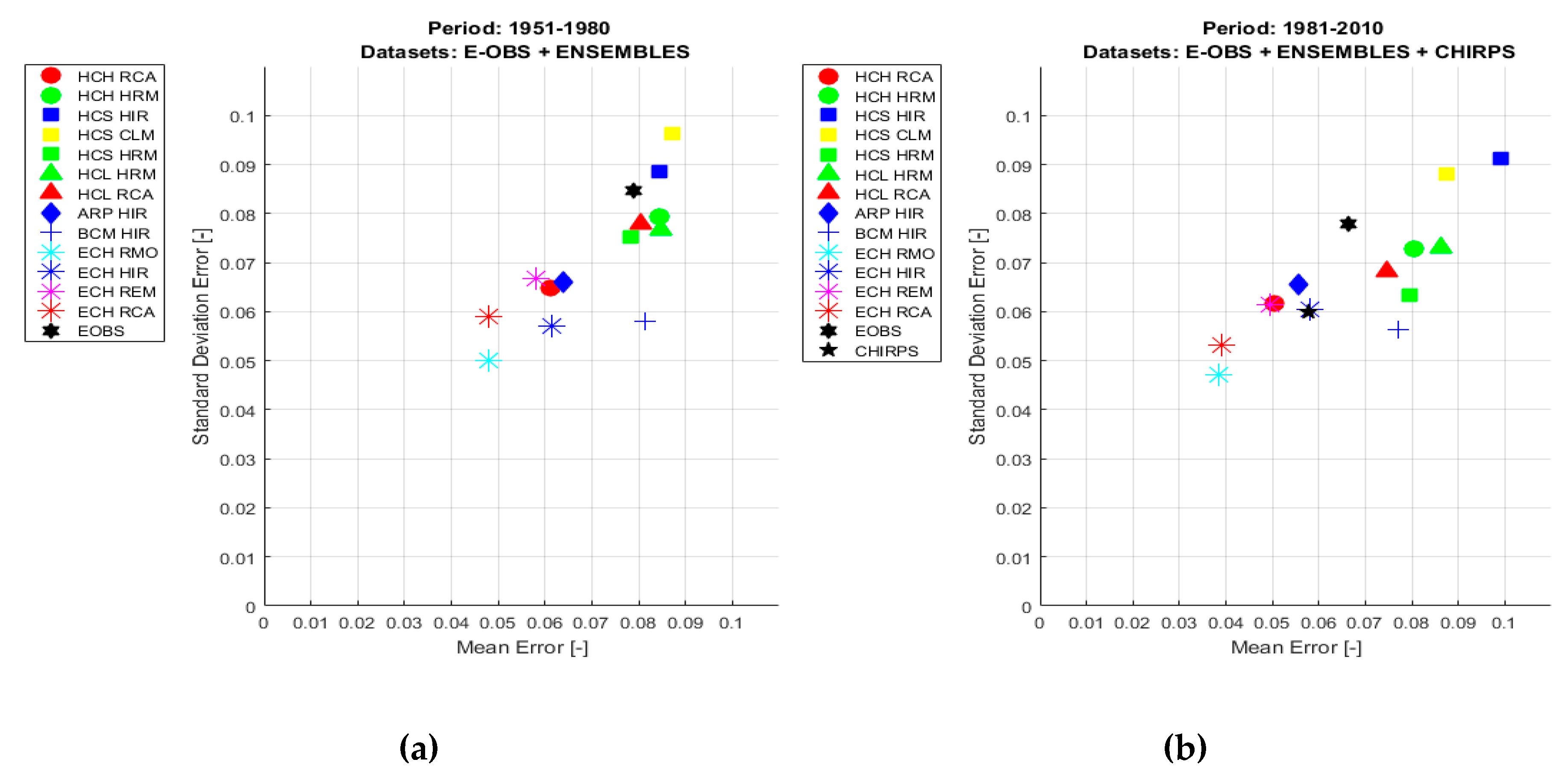
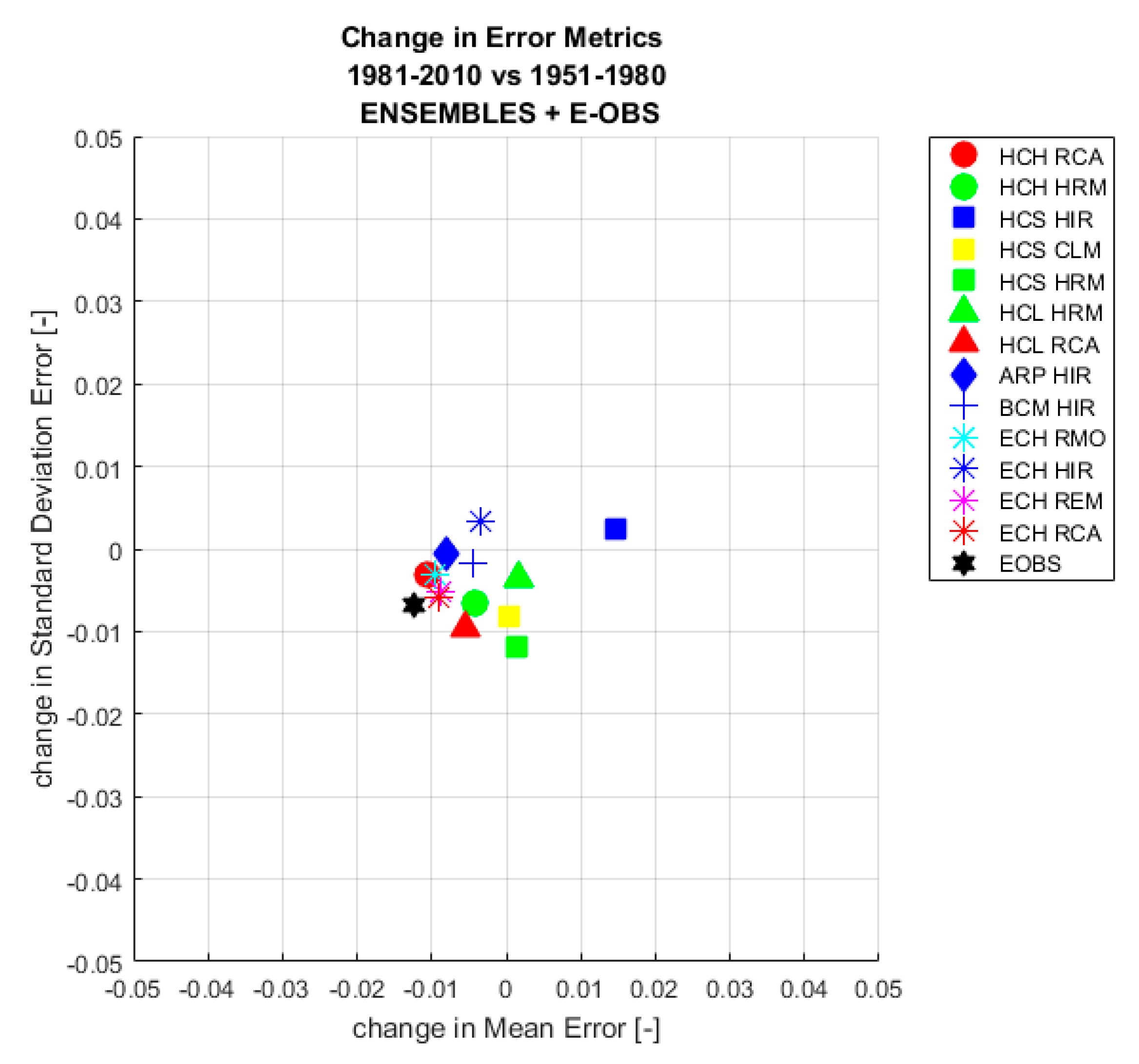
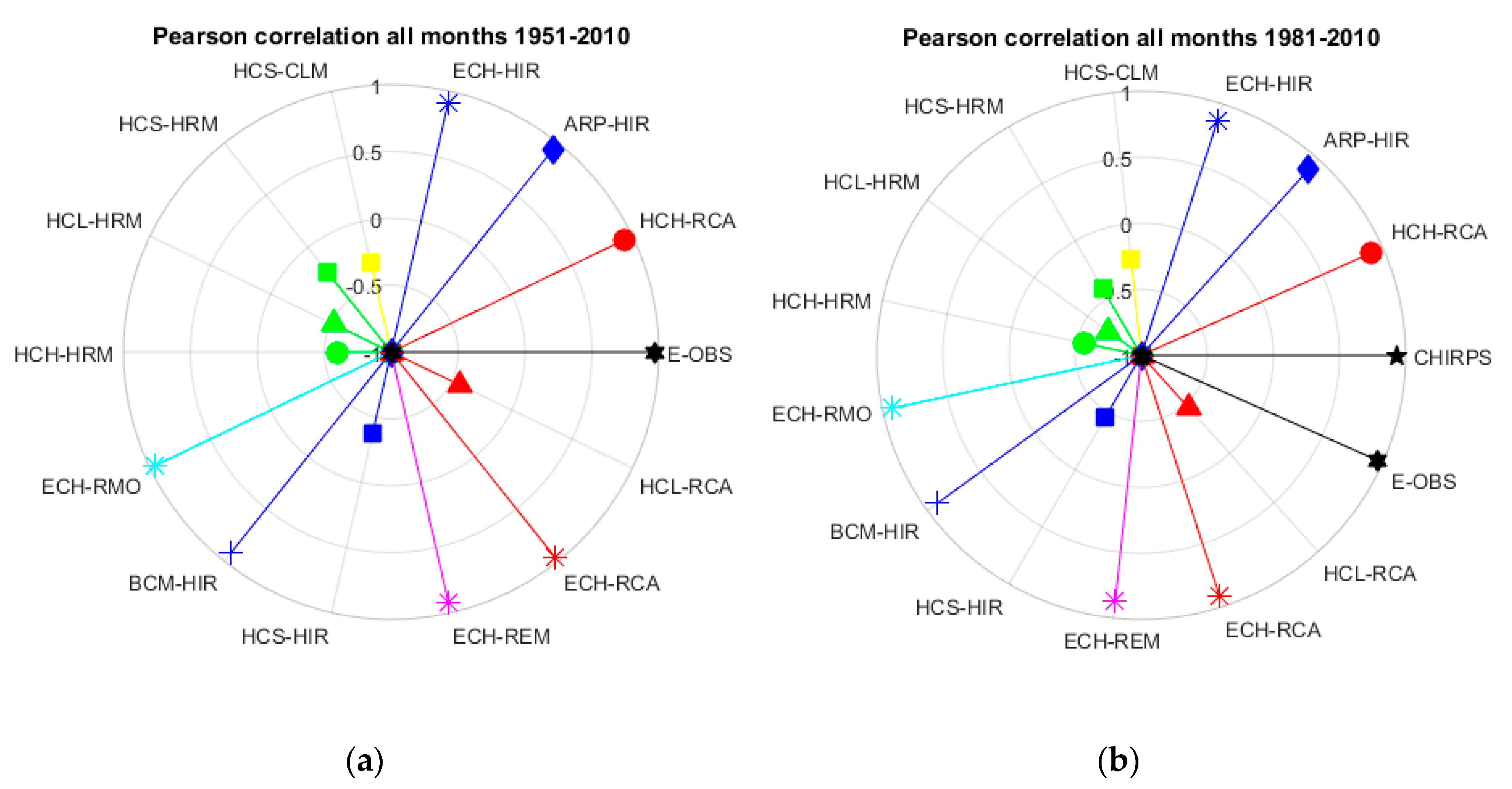
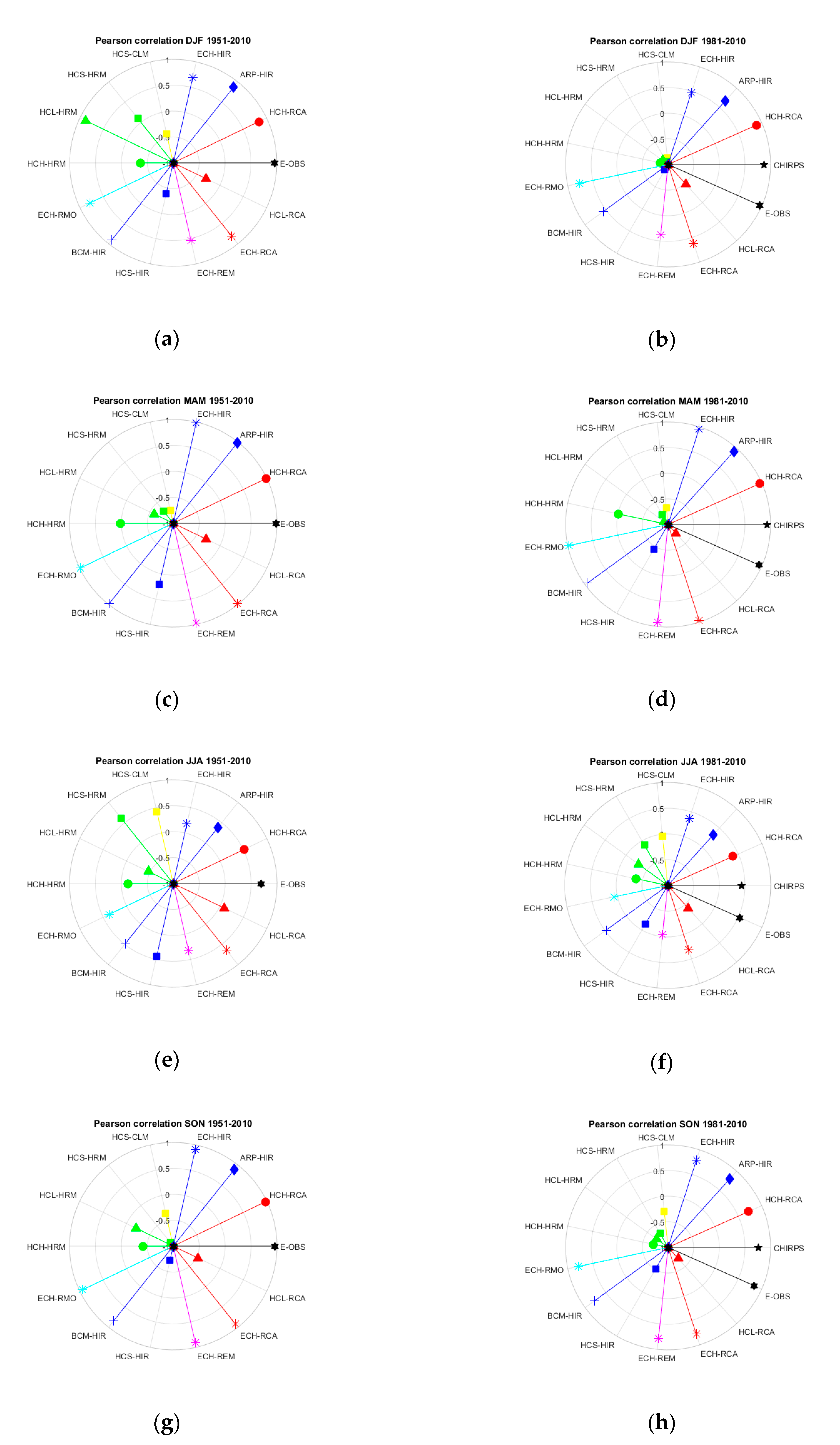
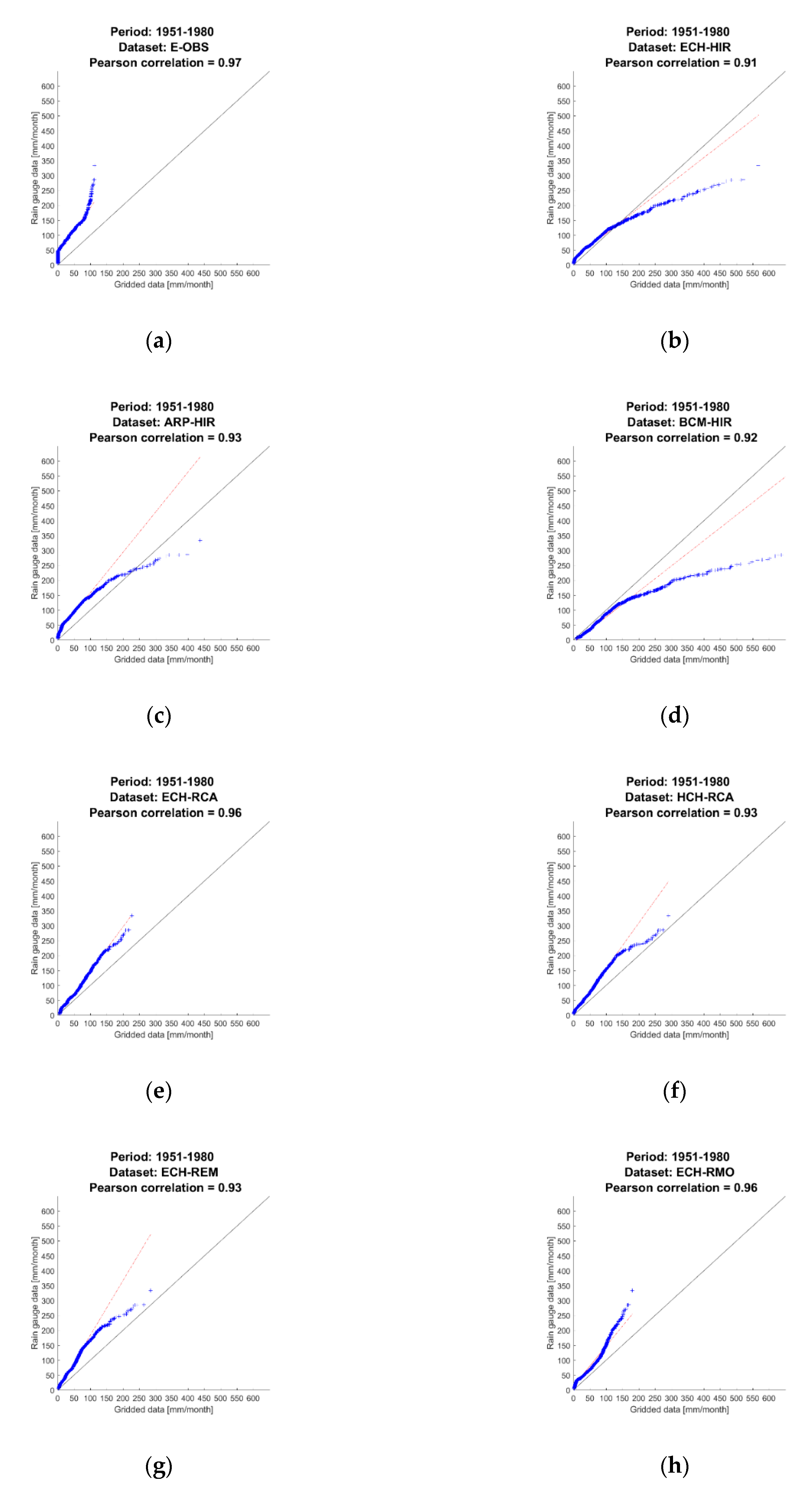
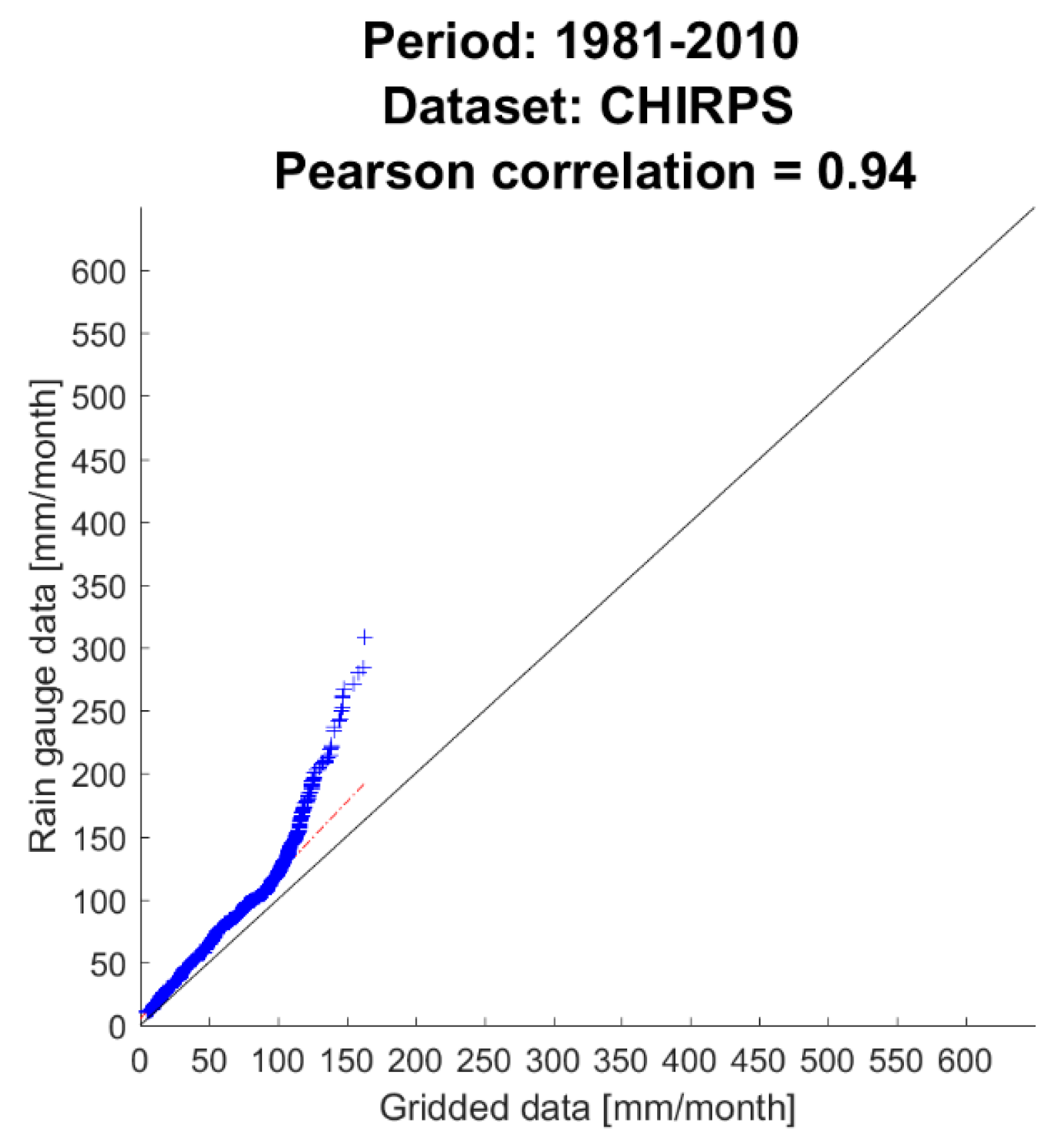
| Acronym | Global Climate Model |
|---|---|
| HCH | Hadley Climate Model 3 (HadCM3) (high sensitivity) |
| HCS | HadCM3 (standard sensitivity) |
| HCL | HadCM3 (low sensitivity) |
| ARP | Climate Model 3 Arpege |
| ECH | Max Planck Institute (MPI) European Centre HAMburg model 5 (ECHAM 5) |
| BCM | Bjerknes Centre for Climate Research Bergen Climate Model 2.0 |
| Acronym | Regional Climate Model |
|---|---|
| RCA | Swedish Meteorological and Hydrological Institute (SMHI) Rossby Centre regional Atmospheric (RCA) climate model |
| HIR | Danish Meteorological Institute (DMI) HIgh Resolution limited-European Centre HAMburg model 5 (HIRHAM5) |
| CLM | Eidgenössische Technische Hochschule (ETH) Zurich Community Land Model |
| HRM | Hadley Centre Regional Model 3Q3 |
| RMO | Koninklijk Nederlands Meteorologisch Instituut Regional Atmospheric Climate MOdel 2 (RACMO2) |
| REM | Max Planck Institute-REgional climate MOdel (REMO) |
| Acronym | Acronym |
|---|---|
| ECH-RCA | HCL-RCA |
| ECH-REM | HCL-HRM |
| ECH-HIR | HCS-HRM |
| ECH-RMO | HCS-CLM |
| BCM-HIR | HCS-HIR |
| ARP-HIR | HCH-HRM |
| HCH-RCA |
© 2019 by the authors. Licensee MDPI, Basel, Switzerland. This article is an open access article distributed under the terms and conditions of the Creative Commons Attribution (CC BY) license (http://creativecommons.org/licenses/by/4.0/).
Share and Cite
Caroletti, G.N.; Coscarelli, R.; Caloiero, T. Validation of Satellite, Reanalysis and RCM Data of Monthly Rainfall in Calabria (Southern Italy). Remote Sens. 2019, 11, 1625. https://doi.org/10.3390/rs11131625
Caroletti GN, Coscarelli R, Caloiero T. Validation of Satellite, Reanalysis and RCM Data of Monthly Rainfall in Calabria (Southern Italy). Remote Sensing. 2019; 11(13):1625. https://doi.org/10.3390/rs11131625
Chicago/Turabian StyleCaroletti, Giulio Nils, Roberto Coscarelli, and Tommaso Caloiero. 2019. "Validation of Satellite, Reanalysis and RCM Data of Monthly Rainfall in Calabria (Southern Italy)" Remote Sensing 11, no. 13: 1625. https://doi.org/10.3390/rs11131625
APA StyleCaroletti, G. N., Coscarelli, R., & Caloiero, T. (2019). Validation of Satellite, Reanalysis and RCM Data of Monthly Rainfall in Calabria (Southern Italy). Remote Sensing, 11(13), 1625. https://doi.org/10.3390/rs11131625





